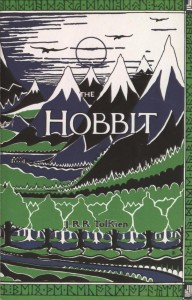Every previous plot point has led up to this moment. The inciting incident ushered the protagonist into the main conflict. The Act I choice saw him committing to a goal influenced by that conflict. The midpoint gave him time to reflect and rethink his plans, and then the Act II crisis nearly destroyed his faith in his goal (and in himself). Now it’s time for the scene that readers have been waiting for, and the scene that serves as the story’s most salient example of its themes: the climax.
Today’s installment of Developing Themes In Your Stories focuses on how the climax gives a story genuine meaning. Using brainstorming and writing activities, we’ll learn how literary themes emerge through the protagonist’s actions and the resulting outcome. And, we’ll see if the same themes that appeared in past plot points of J.R.R. Tolkien’s The Hobbit and Paulo Coelho’s Veronika Decides to Die resonate here as well.
Understand What the Climax Is Meant to Accomplish
The climax isn’t just one of the final scenes in a story. It’s also the final confrontation between the protagonist and the antagonist, and the moment when the protagonist must reach his story goal and resolve the main conflict. Whether he actually achieves his goal will depend on what kind of story you’re writing. But for the most part, the climax fulfills the story’s earlier promises while offering some surprises that lead to a satisfying ending.
This means that the climax represents the heart of the story’s themes. Yes, we did say in Part 10 that the Act II crisis pulses with a story’s themes more strongly than any previous plot point. But with the climax, the stakes have never been higher. If the protagonist applies what he’s learned earlier in the story and does what he needs to do here, he could very well succeed. But if he fails, the desires he’s wanted so badly could slip away forever, and his greatest fears would manifest instead.
To put it simply, the climax emphasizes the reason for the story. It shows what the protagonist’s journey has been all about and why that journey has been worth all of his pain and suffering. Sounds like part of our working definition of “theme,” doesn’t it?
Set the Stage for the Climax
Thanks to the “why” established in Part 10, the protagonist has moved on from the Act II crisis. He might not believe he’s ready to face the antagonist or resolve the main conflict. However, he is ready, because he has all the knowledge, skills, tools, etc. that he needs. Now, in either a single scene or a sequence of scenes, he’ll use those resources to attempt to achieve his story goal, all the while proving he has grown since he first met him.
Before this can happen, it’s important to set the stage for the climax. An effective way of doing this is by asking questions using the 5W1H Method (who, what, where, when, why, and how). For example, who is involved in the climax (protagonist, antagonist, supporting characters, etc.)? Where and when does the climax take place? What last-minute twists raise the stakes one last time? Understanding, and even picturing, how the climax might play out can help you determine what the protagonist will need to do to bring the conflict to a close.
Let’s set the stage for each climax in our two example stories:
 The Hobbit:
The Hobbit:
Despite his best efforts, Bilbo is unable to prevent war between the Dwarves and the joint Elvish-Men forces. The situation grows more dire when the wizard Gandalf learns that a host of Goblins, Wild Wolves, and bats are preparing to attack the Dwarves as revenge for the Goblin King’s death earlier in the book. This news forces the Dwarves, Elves, and Men to finally reconcile so they can fight against their common enemy. The legendary battle that takes place after this is known as the Battle of the Five Armies (303 – 309).
Veronika Decides to Die:
Veronika and Eduard successfully escape from the mental institution. They enjoy dinner and wine at an expensive restaurant in downtown Ljubljana, then fall asleep outside a nearby castle. Throughout the evening, they tell jokes and stories, and have more serious conversations about love, wisdom, and other ways in which one can find meaning in life. When a police officer finds them the next morning, Eduard’s initial attempt to wake Veronika fails. (200 – 205)
Activity #1: Using the 5WH1 Method, review or brainstorm the scene or sequence of scenes that act as your WIP’s climax. Pay particular attention to any twists that could raise the stakes and make the protagonist’s final attempt to reach his story goal even more challenging.
Have the Protagonist Perform a “Moment of Truth”
The protagonist’s final action during the climax can be quite symbolic. Its primary intent is to help him defeat the antagonist, end the main conflict, and reach his story goal. But upon a closer look, this action often embodies the lessons that the protagonist has learned throughout the story. In other words, he puts one or more of the story’s themes into practice. This is what I like to call the protagonist’s “moment of truth.”
So, what will your protagonist’s moment of truth be? Why does he take this particular action? Keep in mind that this moment doesn’t have to be heroic in nature. It should fit your story’s plot and genre, as well as demonstrate the protagonist’s awareness of what he must do to decisively end the story-long struggle. And while you don’t have to identify any themes right now, it might help to look back on which themes have emerged during earlier plot points.
What’s interesting about our two case studies is how different their moments of truth are. Veronika Decides to Die is a great example of a “non-heroic” act, as described above. The Hobbit, on the other hand, throws a curveball because it’s a multiple point-of-view story. Even though Bilbo Baggins is the titular character, one of the other viewpoint characters – and an appropriate choice, at that – performs the moment of truth instead:
 Veronika Decides to Die:
Veronika Decides to Die:
As Eduard begins to despair that Veronika has died, Veronika stirs and opens her eyes. When she asks what has happened, Eduard answers, “Nothing… Or rather a miracle happened: another day of life.” (205) This simple act of waking to live another day is Veronika’s “moment of truth.”
The Hobbit:
Bilbo doesn’t participate in the Battle of the Five Armies, instead watching it from a nearby hill before being knocked unconscious. The “moment of truth” therefore comes from Thorin Oakenshield, who, along with his fellow Dwarves, joins the battle in a last-ditch and ultimately victorious effort to protect his home and his people (306). His actions remind us that Bilbo isn’t the only courageous character, and that bravery comes in myriad forms.
Activity #2: Determine possible actions that protagonist could perform at the end the climax. Why does he perform each one? How do these actions symbolize his growth during the story? Is he aware of how or why this action is crucial in resolving the main conflict? Finally, which action would be most fitting for your story, and why?
Did the Protagonist (and Other Characters) Achieve His Goal?
One crucial question remains once the climax is over: Did the protagonist achieve his story goal? Again, this will depend on your intentions for the story. But regardless of whether the protagonist succeeds, the moment after the climax ends is the ideal time to reflect on what has transpired and its overall impact on the protagonist and the other characters.
First, it’s a good idea to revisit the goals established during the inciting incident and the Act I choice. Compare those goals to the goal he reaches for during the climax. Did it remain the same? Or did it evolve because of his experiences in the story and/or a change in perspective?
Then, consider the climax’s results and consequences. Some of this might be explored or hinted at during the story’s resolution scenes, if needed. Still, it’s beneficial to grasp how the end affects your protagonist and his world at large. For example, if the protagonist achieved his story goal, what does he receive physically (e.g., tangible objects, loved ones) and emotionally in return? What are his thoughts and emotions right now? Are there disadvantages to his victory? Did the supporting characters get what they want? You can also rephrase these questions for stories where the protagonist doesn’t achieve his story goal, so you can study the impact of his failure instead.
Did Bilbo and Veronika each achieve their story goals? Let’s find out:
The Hobbit:
Bilbo achieved his goal (having the adventure of a lifetime) before the Battle of the Five Armies. Now he can return home with treasure, tales to share, and a mysterious, powerful ring in his pocket. In contrast, Thorin Oakenshield achieved his goal (reclaiming his home, Erebor) as well, but at the expense of his own life. It’s also important to note that Bilbo and Thorin reconcile before Thorin’s death so that both characters part as friends.
Veronika Decides to Die:
Before Veronika arrived at the mental institution, she had hoped to die on her own terms. However, her goal gradually changed to living the rest of her life to the fullest. The climax proves that she now embraces that philosophy: She returns to the outside world with a lover at her side and inexplicably wakes up every morning despite her doctor’s grave prognosis.
Activity #3: Review the results of the climax and the protagonist’s moment of truth. Was the protagonist able to achieve his story goal? Has that goal evolved or remained the same since the inciting incident? Also, how do the results and/or consequences of the climax impact the protagonist and other characters? What are the advantages and disadvantages of the protagonist’s success (or failure)?
With Theme, Repetition Is Just as Important as the “Why”
Now that you’ve explored the climax’s possible endings and results, it’s time to unearth its themes. Whatever themes arising from this scene should be familiar by now, since they should also have emerged during previous plot points. This is no coincidence, though. Repetition is one of the key elements in our working definition of “theme,” just as much as why the protagonist performs his moment of truth or why he wanted his story goal in the first place.
As you go over your answers for Activities #1 through #3, see what themes stand out during the climax. Which ones are illustrated in the plot or external conflict? How about internally, through the protagonist’s actions and motivations? Also, consider the protagonist’s success or failure in resolving the main conflict and achieving his story goal. What other insights can you infer about the story’s themes based on how the story ends?
Here are the themes I found when analyzing our two examples. Can you think of others?
- The Hobbit: Courage, home, loyalty, adventure / exploration, war
- Veronika Decides to Die: Death / mortality, love, happiness, choices / personal power
Activity #4: Review your answers for Activities #1 through #3, and write down any themes that appear during your story’s climax. Which ones in particular are highlighted in your protagonist’s moment of truth? How do the results of the climax offer additional meaning or insight into these themes? Also, compare the climax’s themes to the themes you discovered in previous plot points. Do any scenes share the same themes?
What are some of the climactic scenes from your favorite stories? How do they highlight the story’s themes? And, what does the protagonist(s) in your WIP do to try to end the main conflict or defeat the antagonist? How does this action or scene represent your story’s themes?

Sara Letourneau is a fantasy writer in Massachusetts who devours good books, loves all kinds of music, and drinks too much tea. In addition to writing for DIY MFA, she is a Resident Writing Coach at Writers Helping Writers and is hard at work on a YA fantasy novel. She also freelanced as a tea reviewer and music journalist in the past. Her poetry has appeared in The Curry Arts Journal, Soul-Lit, The Eunoia Review, Underground Voices, and two print anthologies. Visit Sara at her personal blog, Twitter, and Goodreads.







